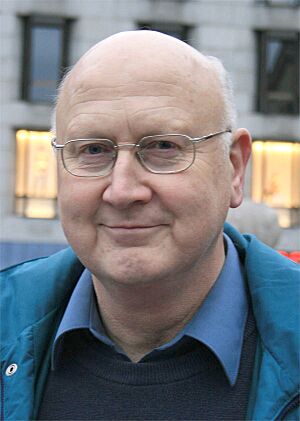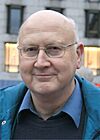Red Party (Norway) facts for kids
Quick facts for kids
Red Party
Rødt
Raudt |
|
|---|---|
 |
|
| Leader | Marie Sneve Martinussen |
| Founded | 11 March 2007 |
| Merger of |
|
| Headquarters | Dronningens Gate 22, Oslo |
| Newspaper | Klassekampen (largest share of ownership) |
| Youth wing | Red Youth |
| Membership (2024) | |
| Ideology |
|
| Political position | Left-wing to far-left |
| Nordic affiliation | Nordic Green Left Alliance |
| Colours | Red |
| Slogan | Fordi fellesskap fungerer ('Because community works') |
| Storting |
8 / 169
|
| County Councils |
20 / 574
|
| Municipal Councils |
192 / 9,344
|
The Red Party (Bokmål: Rødt; Nynorsk: Raudt) is a political party in Norway. It was started in March 2007. This happened when two older parties, the Red Electoral Alliance and the Workers' Communist Party, joined together. The Red Party is known for its left-wing and far-left ideas.
The party's main goal is to create a society where everyone is equal. They call this a "classless society," which is what Karl Marx talked about as communism. They also want to change capitalism to socialism. This means they want more public services and for big businesses to be owned by the country. The Red Party does not want Norway to join the European Union.
The Red Party has members in local and regional governments across Norway. In the 2013 national election, they almost won a seat in Parliament. They finally got their first seat in the Storting (Norway's Parliament) in the 2017 election. In the 2021 election, they had their best result ever, winning eight seats in Parliament.
Contents
What the Red Party Believes In
The Red Party is a socialist party that follows Marxism. They believe that big differences in wealth and unfairness are the biggest problems for democracy and a good society. They think that the current economic system, capitalism, causes these problems.
Social and Environmental Ideas
The Red Party wants a society where everyone is treated equally. They believe in human rights, helping each other, and celebrating differences. A key goal is to make sure everyone can take part in politics fairly. They think this can only happen by changing the current economic system.
The party also believes that the way the economy works now harms nature. They want an economy that respects the Earth's limits. The Red Party supports the queer community and works for feminism and against racism. They also support other policies that help people have more choices in their lives.
Economic Plans and Welfare
The Red Party strongly supports the "Nordic model" of society. This model focuses on community solutions, which they believe have created good living standards. They want to keep Norway's welfare state strong. This means they support high taxes on wealthy people to help reduce economic unfairness.
They believe that workers should have a strong voice. They encourage their members to join labor unions. A member of Parliament, Mímir Kristjánsson, has said that socialist parties need to protect the welfare system for everyone. The party also works against companies that make profits from public services like kindergartens and elderly care. They argue this can lead to lower pay for workers.
Views on Democracy
The Red Party believes that the current economic system is not truly democratic. They say that a small group of rich people control big banks and companies. They want to see more democracy in workplaces.
The party is committed to making democratic systems stronger. They believe in free speech, the right to form groups, fair elections, free media, and independent courts. These are all important parts of a fair society.
Foreign Policy Ideas
The Red Party believes in helping people around the world. They want to show solidarity with those who are struggling due to economic competition, climate change, unfair treatment, or war. They see this international support as a key part of the labor movement.
The party is against Norway being part of the EEA agreement. They want a different trade agreement instead. They worry that the EEA agreement could lead to unfair working conditions and less control for Norway. They also want Norway to leave NATO, but this is not their top priority.
The Red Party has supported Ukraine during the Russian invasion of Ukraine. This includes supporting Norway sending weapons to Ukraine. However, they are against sending Norwegian soldiers or certain fighter jets to Ukraine. The party also supports Norway recognizing Palestine as a state.
How the Red Party Started
Party Formation in 2007
The Red Party was formed on March 7, 2007. It was created by combining two older parties: the Red Electoral Alliance and the Workers' Communist Party. These two parties had worked together for many years. The Workers' Communist Party had even started the Red Electoral Alliance to help spread their ideas in elections.
Before the merger, some members wanted to remove any mention of communism from the new party's program. A secret meeting was held, and most members agreed to the merger. The Workers' Communist Party officially ended in April 2007. When the new party was founded, they wanted to offer different ideas from other political groups in Norway.
Early Years (2007–2010)
Torstein Dahle was chosen as the first leader of the Red Party in February 2007. Some people thought he might not lead the party in a new direction. Ingrid Baltzersen, who was the leader of the Workers' Communist Party, became the deputy leader.
In 2007, Dahle made headlines when he said that Afghan rebels had the right to fight Norwegian soldiers in Afghanistan. He later clarified that he did not support the death of Norwegian soldiers. For the 2007 local elections, the party had to use the old name, Red Electoral Alliance, because their new name was not yet approved.
After the 2007 election, some party members felt the results were not good enough. A leading figure, Trond Andresen, resigned. He believed the party needed to change its image to succeed.
Thomassen's Leadership (2010–2012)
Turid Thomassen became the leader of the Red Party in May 2010. She had a lot of experience from both the Workers' Communist Party and the Red Electoral Alliance. Bjørnar Moxnes, who used to lead the youth wing, became the deputy leader.
Moxnes' Leadership (2012–2023)
Bjørnar Moxnes was elected party leader in May 2012. During his time as leader, the party grew a lot. In the 2021 Norwegian parliamentary election, the party got enough votes to enter the Storting with eight members. This was a big achievement for them.
Moxnes stepped down as party leader on July 24, 2023. He returned to politics in January 2024. Many people said that Moxnes helped make the Red Party more accepted by the public.
Sneve Martinussen's Leadership (2023–Present)
Marie Sneve Martinussen became the acting leader of the Red Party in July 2023. In April 2024, a committee suggested she become the permanent leader. She had been the deputy leader since 2012. People expected her to continue the party's current plans.
During her time as leader, she has focused on making the party more appealing to a wider group of people. She also wants to "restore trust in democracy." In late 2024, she said that the Red Party was willing to join a government after the 2025 Norwegian parliamentary election if they had the chance.
Youth Involvement
The Red Party has a youth wing called Red Youth. It was started in 1963, even before the Red Party itself. The current leader of Red Youth is Amrit Kaur. The youth wing strongly supported the merger of the two older parties. They felt it was hard to be a youth group under two different parent parties.
Some former members of the Red Electoral Alliance felt there was a gap between older and younger members in the Red Party. They believed that older members, who had been there since the beginning, had too much control. These concerns were shared by others in the party.
Election Results
In the 2007 local elections, the Red Party received 2.1% of the votes. After these elections, Knut Henning Thygesen became the party's first and only mayor elected directly in the municipality of Risør.
In the 2009 Norwegian parliamentary election, the party got 1.3% of the votes and no seats in Parliament. They came closest to winning a seat in Oslo. In the 2011 Norwegian local elections, they won 1.7% of the votes.
The Red Party finally won its first seat in the Storting in the 2017 Norwegian parliamentary election. This happened in Oslo, with party leader Moxnes being elected. In the 2021 Norwegian parliamentary election, the Red Party had its best result ever. They received 4.6% of the votes and won eight seats in Parliament.
National Election Results
| Election | Leader | Votes | % | Seats | +/– | Position | Status |
|---|---|---|---|---|---|---|---|
| 2009 | Torstein Dahle | 36,219 | 1.3 |
0 / 169
|
New | No seats | |
| 2013 | Bjørnar Moxnes | 30,751 | 1.1 |
0 / 169
|
No seats | ||
| 2017 | 70,522 | 2.4 |
1 / 169
|
Opposition | |||
| 2021 | 135,574 | 4.7 |
8 / 169
|
Opposition |
Local Election Results
| Year | Vote % | Type |
|---|---|---|
| 2007 | 1.9 2.1 |
Municipal County |
| 2011 | 1.5 1.7 |
Municipal County |
| 2015 | 2.0 2.2 |
Municipal County |
| 2019 | 3.8 3.9 |
Municipal County |
Party Leaders
| No. | Portrait | Leader | Took office | Left office | Time in office |
|---|---|---|---|---|---|
| 1 | Torstein Dahle | February 2007 | 30 May 2010 | 3 years, 118 days | |
| 2 | Turid Thomassen | 30 May 2010 | 6 May 2012 | 1 year, 342 days | |
| 3 | Bjørnar Moxnes | 6 May 2012 | 24 July 2023 | 11 years, 79 days | |
| 4 | Marie Sneve Martinussen | 24 July 2023 | Incumbent | 2 years, 137 days |
See also
 In Spanish: Partido Rojo para niños
In Spanish: Partido Rojo para niños







